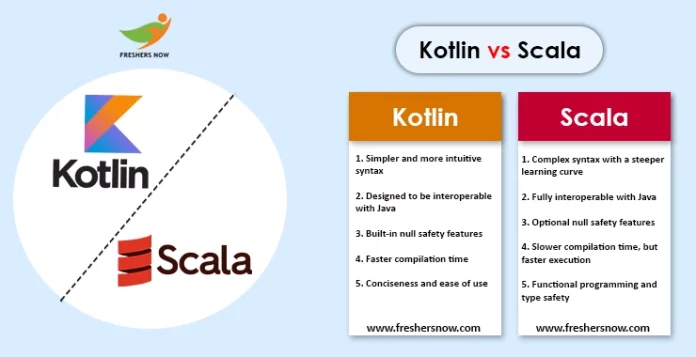
Difference between Kotlin and Scala: Kotlin and Scala are two popular programming languages that are widely used in modern software development. Both Kotlin and Scala are designed to run on the Java Virtual Machine (JVM), which means that they can be used to develop applications that are compatible with Java. However, there are significant differences between Kotlin and Scala that make them distinct from each other.
Comparison Between Kotlin and Scala
In this article, we will explore the key differences between Kotlin and Scala, including their syntax, performance, features, and more. By the end of this comparison between Kotlin and Scala, you should have a better understanding of which language is best suited for your specific programming needs.
What is the Difference Between Kotlin and Scala?
What is Kotlin?
Kotlin is a modern, statically-typed programming language designed to interoperate with Java and other JVM-based languages. It was developed by JetBrains, the same company behind popular IDEs like IntelliJ IDEA, and was first released in 2011. Kotlin is designed to address many of the pain points of Java, such as null safety, concise syntax, and support for functional programming concepts. It can be used to build a wide range of applications, from Android mobile apps to server-side web applications. Kotlin is fully interoperable with Java, which means that Java code can call Kotlin code and vice versa, making it easy to integrate into existing Java-based projects. It also has excellent tooling support, with a rich ecosystem of libraries and frameworks available through the Kotlin Package Index (KPI). Kotlin is gaining popularity in the Java community due to its readability, expressiveness, and conciseness, making it an excellent choice for modern, agile software development.
What is Scala?
Scala is a modern, statically-typed programming language designed to integrate object-oriented and functional programming concepts. It was first released in 2004 and is built on top of the Java Virtual Machine (JVM), which means that Scala code can interoperate seamlessly with Java code. Scala provides a concise syntax and a powerful type system, which allows developers to write code that is both expressive and safe. It supports functional programming concepts such as higher-order functions, immutable data structures, and lazy evaluation, which can help simplify complex code and make it easier to reason about. Scala is often used in big data processing and distributed systems, as it provides excellent support for concurrency and parallelism. It also has a robust ecosystem of libraries and frameworks, including Akka, Spark, and Play, which make it easy to build scalable, high-performance applications. With its combination of object-oriented and functional programming features, Scala is an excellent choice for developers who want to write clean, expressive, and maintainable code.
Top 50 Differences Between Kotlin and Scala
Angular and React are popular front-end frameworks used for web development. Here are the Top 50 Differences Between Kotlin and Scala, highlighting their unique features and capabilities.
| Sl. No. | Kotlin | Scala |
|---|---|---|
| 1 | Developed by JetBrains in 2011 | Developed by Martin Odersky in 2003 |
| 2 | Statically typed programming language | Statically typed programming language |
| 3 | Interoperable with Java | Interoperable with Java |
| 4 | More concise syntax than Java | More concise syntax than Java |
| 5 | Null safety feature prevents NullPointerExceptions | Optional types prevent NullPointerExceptions |
| 6 | Offers extension functions | Offers implicit conversions |
| 7 | Emphasizes on simplicity and readability | Emphasizes on functional programming and type inference |
| 8 | Does not support operator overloading | Supports operator overloading |
| 9 | Offers named arguments | Offers named and default arguments |
| 10 | Supports SAM (Single Abstract Method) conversion | Supports SAM conversion |
| 11 | Provides data classes for modeling data | Provides case classes for modeling data |
| 12 | Offers a type inference feature | Offers a more powerful type inference feature |
| 13 | Supports inline functions | Supports higher-order functions |
| 14 | Provides delegated properties for efficient code | Provides implicit parameters for efficient code |
| 15 | Offers a safe casting mechanism | Offers a pattern matching mechanism |
| 16 | Supports coroutines for asynchronous programming | Supports Futures and Promises for asynchronous programming |
| 17 | Uses the “when” keyword for pattern matching | Uses the “match” keyword for pattern matching |
| 18 | Offers smart casts for working with nullable types | Offers type refinement for working with types |
| 19 | Offers string interpolation | Offers string interpolation |
| 20 | Provides a range of collections and sequences | Provides a range of collections and sequences |
| 21 | Supports property getters and setters | Supports property getters and setters |
| 22 | Offers an Elvis operator for null safety | Offers an Option type for null safety |
| 23 | Offers a type-safe builder pattern | Offers a type-safe builder pattern |
| 24 | Supports functional programming concepts | Emphasizes on functional programming concepts |
| 25 | Provides an open class keyword for inheritance | Provides an open class and sealed trait for inheritance |
| 26 | Offers a sealed class keyword for type safety | Offers a sealed trait for type safety |
| 27 | Offers a delegate keyword for delegation | Offers a delegate keyword for delegation |
| 28 | Offers an annotation keyword for metadata | Offers an annotation keyword for metadata |
| 29 | Provides a companion object for static members | Provides a companion object for static members |
| 30 | Offers extension properties | Offers extension methods |
| 31 | Offers safe call operator (?.) for null safety | Offers safe call operator (?.) for null safety |
| 32 | Offers Elvis operator for null safety | Offers Option type for null safety |
| 33 | Supports destructuring declarations | Supports destructuring declarations |
| 34 | Provides lambda expressions for functional programming | Provides lambda expressions for functional programming |
| 35 | Offers a hierarchy of exceptions | Offers a hierarchy of exceptions |
| 36 | Provides the “in” keyword for checking element presence | Provides the “contains” method for checking element presence |
| 37 | Offers a range of control flow statements | Offers a range of control flow statements |
| 38 | Supports function overloading | Supports function overloading |
| 39 | Does not support macros | Supports macros |
| 40 | Has a simpler type system | Has a more complex type system |
| 41 | Offers object expressions for creating anonymous objects | Offers anonymous functions for creating objects |
| 42 | Offers a built-in type-safe builder pattern for HTML | Offers a built-in type-safe builder pattern for XML |
| 43 | Supports multiplatform development for Android and other platforms | Supports multiplatform development for various platforms |
| 44 | Supports parallel execution with coroutines | Supports parallel execution with parallel collections |
| 45 | Offers a shorter learning curve compared to Scala | Has a steeper learning curve compared to Kotlin |
| 46 | Offers a simpler syntax for beginners | Offers a more expressive syntax for advanced users |
| 47 | Offers a range of IDEs for development | Offers a range of IDEs for development |
| 48 | Provides built-in support for Android development | Does not provide built-in support for Android development |
| 49 | Offers interoperability with Swift | Does not offer interoperability with Swift |
| 50 | Supports the development of server-side applications | Supports the development of server-side applications |
Conclusion: Kotlin Vs Scala
Angular and React are two popular front-end JavaScript frameworks with their own unique features and functionalities. While both frameworks have their advantages and disadvantages, choosing one over the other ultimately depends on the specific needs of your project and development team. React is known for its simplicity, flexibility, and efficient rendering, making it ideal for large-scale applications with complex data handling. On the other hand, Angular’s opinionated approach and built-in features make it easier for developers to build and maintain complex applications, particularly those that require two-way data binding and complex UI components. Ultimately, whether you choose Angular or React, both frameworks offer powerful tools for building dynamic, responsive, and modern web applications.
We hope that the comprehensive details provided here about the Top 50 Differences Between Angular and React have met your expectations. For more up-to-date information, please ensure to follow freshersnow.com.



